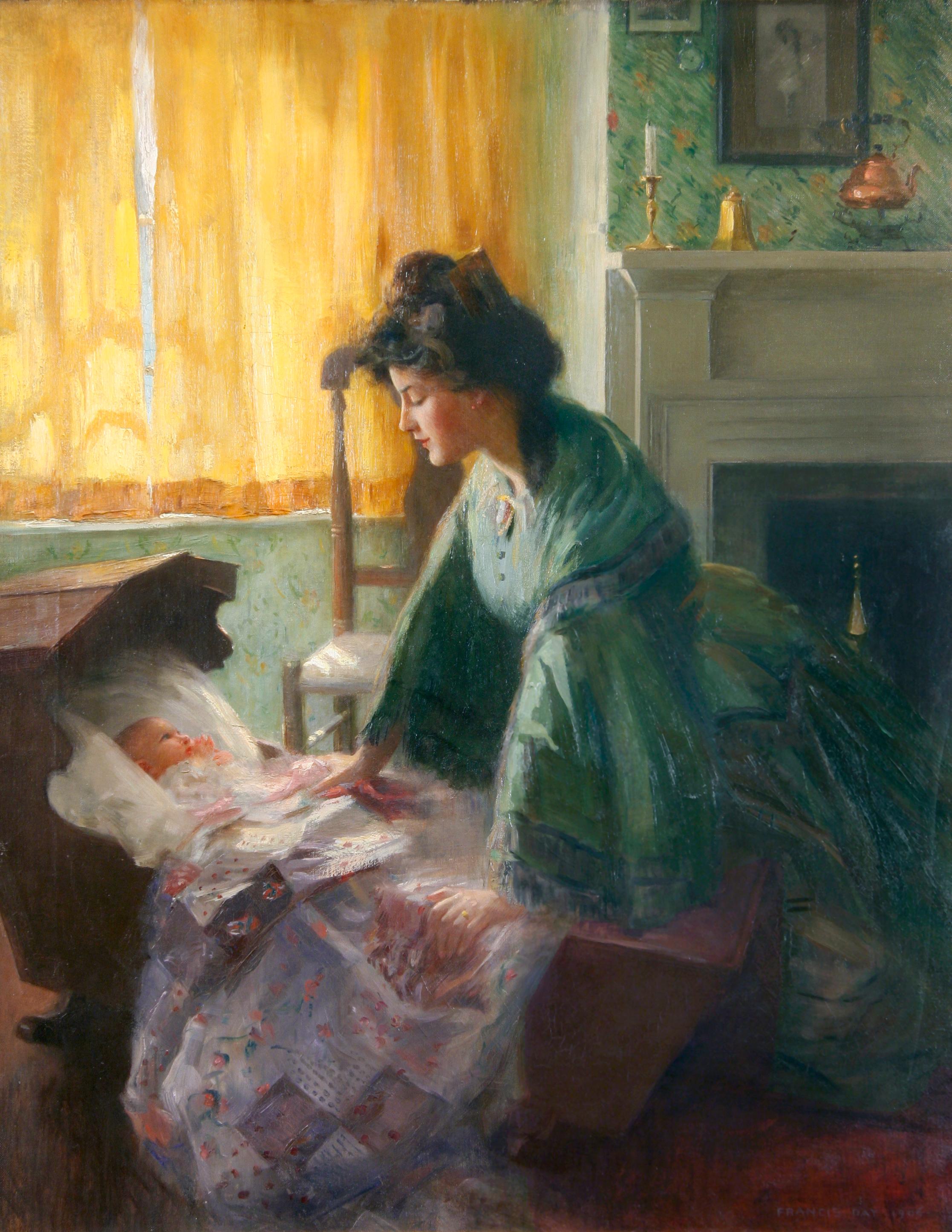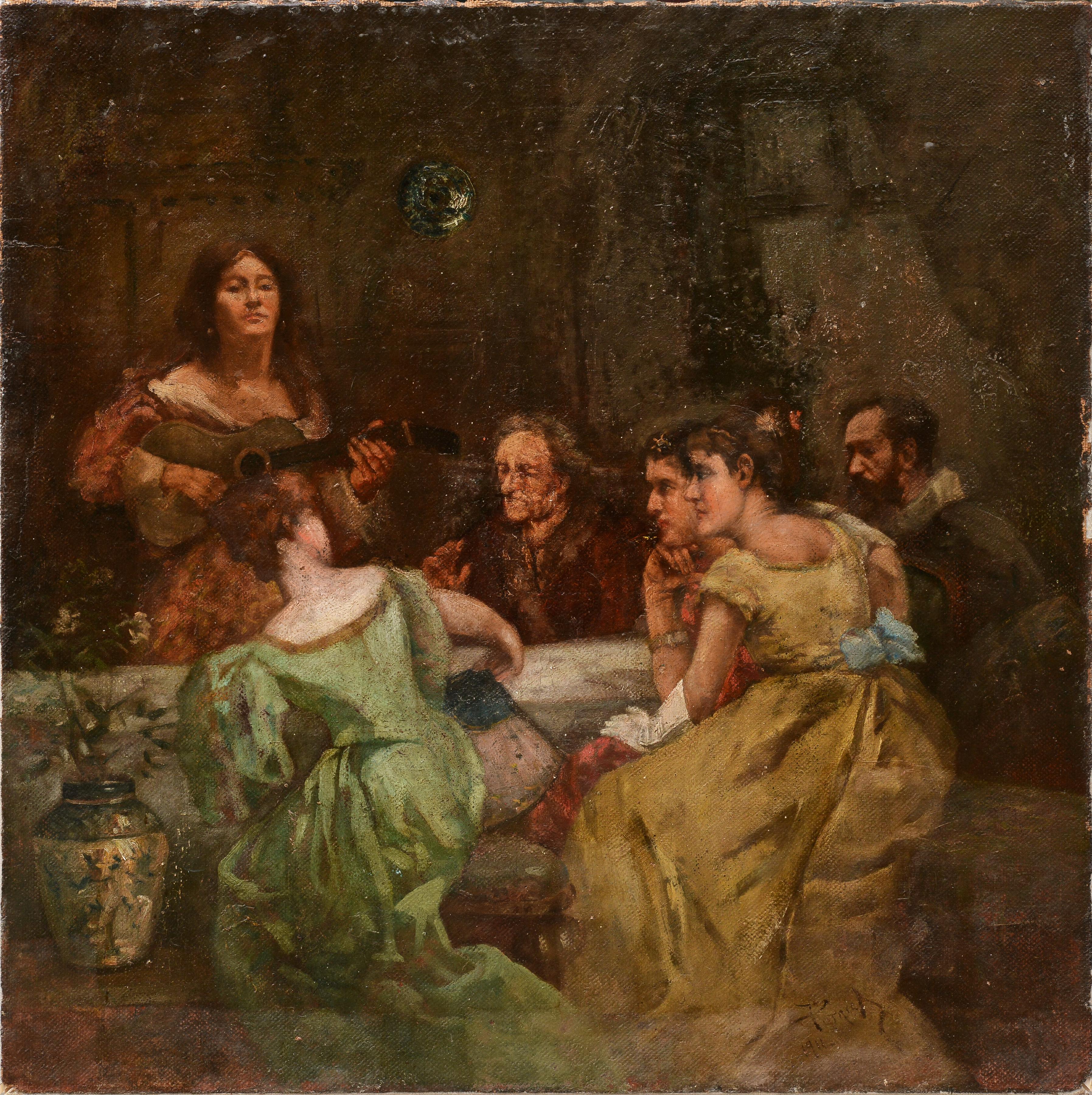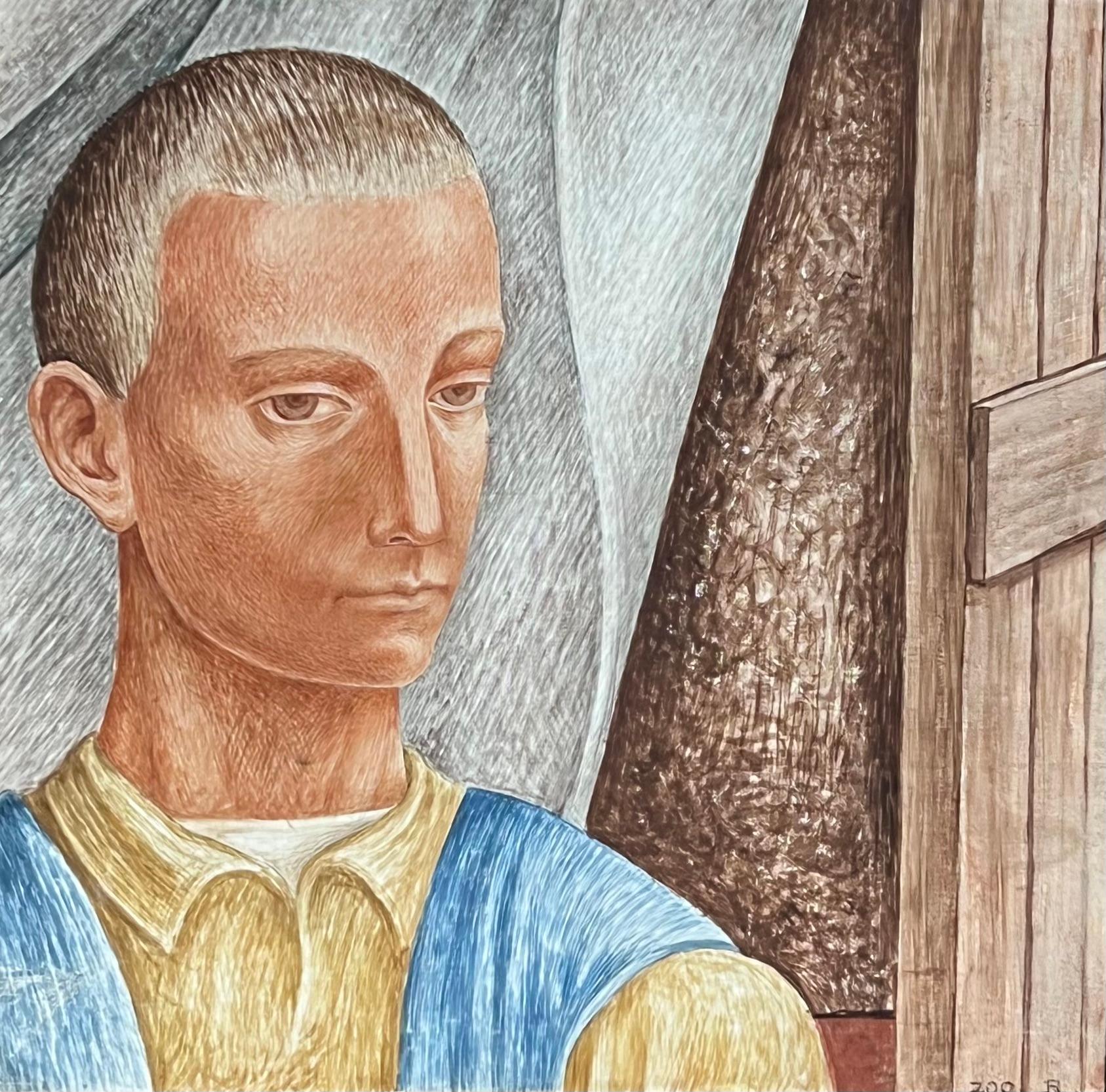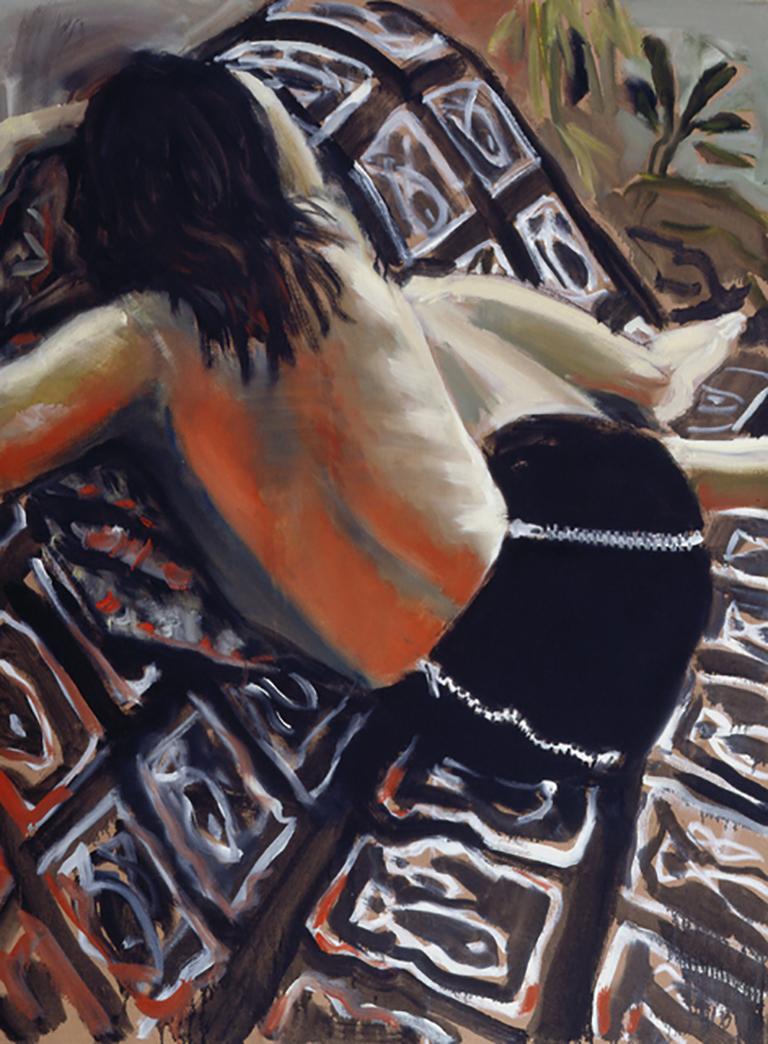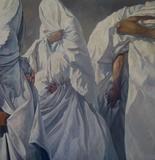Items Similar to Peek-a-Boo
Want more images or videos?
Request additional images or videos from the seller
1 of 8
Seymour Joseph GuyPeek-a-Boo
About the Item
In the latter half of the nineteenth century and into the first decade of the twentieth, New York City art aficionados could count on finding recent work of Seymour Joseph Guy hanging on the walls of the city’s major galleries. Primarily a genre artist, but also a portraitist, between 1859 and 1908 Guy showed more than seventy works at the National Academy of Design. From 1871 to 1903 he contributed over seventy times to exhibitions at the Century Club. From 1864 to 1887, he sent about forty pictures to the Brooklyn Art Association. A good number of these works were already privately owned; they served as advertisements for other pictures that were available for sale. Some pictures were shown multiple times in the same or different venues. Guy was as easy to find as his canvases were omnipresent. Though he lived at first in Brooklyn with his family and then in New Jersey, from 1863 to his death in 1910 he maintained a studio at the Artist’s Studio Building at 55 West 10th Street, a location that was, for much of that period, the center of the New York City art world.
Guy’s path to a successful career as an artist was by no means smooth or even likely. Born in Greenwich, England, he was orphaned at the age of nine. His early interest in art was discouraged by his legal guardian, who wanted a more settled trade for the young man. Only after the guardian also died was Guy free to pursue his intention of becoming an artist. The details of Guy’s early training in art are unclear. His first teacher is believed to have been Thomas Buttersworth, a marine painter (it is not certain whether this was Thomas Buttersworth, Sr. or Jr.). He then apprenticed with Ambrosini Jérôme (John Parker Jerome, 1810–1883), an academic history painter. In 1851, Guy exhibited a painting depicting a mythological topic at the British Institution. This was so atypical a subject for the artist that it is the first and last mention of such a work. In 1854, the thirty-year-old artist immigrated to America.
Guy arrived with a wife, Anna, and a one-year-old daughter, Edith. Anna’s father, William Barber, was an English engraver who had come to America in 1852. (Barber went on, in 1869, to become chief engraver at the Philadelphia mint.) Guy began his American career as a portrait painter, the most direct means of turning his English training as a figure painter into a source of support for his family. He found a congenial group of artists in Brooklyn, which was an independent city from 1834 until it became part of greater New York in 1898, and played an active role in local art activities. In 1859, Guy was among the artists who founded the Brooklyn Art Social. He remained involved when the Art Social nucleus founded the Brooklyn Art Association two years later in 1861. In 1866, Guy and John George Brown (1831–1913) were the only two artists involved with both earlier groups who were among the founders of the Brooklyn Academy of Design, an artists-only organization. (Brown was a fellow Englishman who had immigrated in 1853 and also painted genre subjects.) Guy and his wife had a growing family. Alfred was born in 1855, Anna in 1857, Charles in 1859, Frederick in 1861, Arthur in 1864, Jennie in 1866, Seymour in 1869, and Amy in 1873. By 1869 the family had moved to Hackensack, New Jersey (this information comes from the 1870 United States Census). Although Guy left Brooklyn he continued to exhibit there, continuing until 1887. By 1900, Guy and his family had moved to The Bronx, where he lived until his death in 1910.
It is clear, looking at the owners of pictures that Guy exhibited in the 1860s, that the artist found rapid acceptance for his genre subjects. Among these owners were two fellow artists (both of whom were Scottish-born), John Mackie Falconer (1820–1903) and James MacDougal Hart (1828–1901), as well Samuel P. Avery, an engraver who became an influential art dealer. In 1861, Guy was elected an associate at the National Academy of Design in New York. He was admitted as a full academician in 1865. In 1863, Guy moved his studio from 806 Broadway, the old Dodsworth’s Dancing Academy Building between 11th and 12th Streets, to Richard Morris Hunt’s prestigious Studio Building on Tenth Street, where he maintained a presence until at least 1908. In 1867, Guy was among the founders of the American Society of Painters in Water Color. He was also a member of the Artists’ Fund Society, a benevolent organization that raised funds for indigent artists and their families. Guy was invited to join the Century Club as an artist-member in 1888, an affiliation that he greatly valued, judging from his participation in Club exhibitions.
While Guy’s major exhibition focus remained New York City, his works were included in a variety of far-flung venues. Privately-owned pictures were shown at exhibitions in San Francisco, in Philadelphia (at the Pennsylvania Academy of the Fine Arts) and in Boston. He sent works to the Centennial Exhibition in Philadelphia in 1876, to the Paris Exposition in 1900 (where he earned a medal), to the Pan-American Exposition in Buffalo, New York, in 1901 (where he was also a medalist), and to the St. Louis Exposition in 1904, where he received a gold medal.
Guy attracted prestigious patrons throughout his career. In 1867, Henry Tuckerman reported that New York collector Marshall O. Roberts owned four of the artist’s genre works (Book of the Artists, p. 491). Leland Stanford owned a Guy painting that was shown with his collection in San Francisco. Among the owners of his works at the National Academy of Design were William H. Vanderbilt (The Sunday Lesson, no. 424 in 1878) and Thomas B. Clarke (A Bedtime Story, no. 242 in 1879). George Sheldon devoted a chapter to Guy in his 1879 book, American Painters. According to Sheldon, the financier Jay Gould owned Guy’s The Father’s Return. Sheldon appears to have interviewed Guy in 1878. Sheldon tended to be positive about all of his artists, and was no less so about Guy. He describes the artist as “a genre painter almost exclusively, a painter of scenes in American domestic life, an historian in a sense, but never a moralist . . . (p. 69),” and praises his steady work habits and his mastery of “the laws of light and shade,” quoting an anonymous viewer as saying “‘Your pictures look as though I could walk into them.’” “There is no doubt that some of them really look so,” writes Sheldon, “and this is one excellence of Mr. Guy’s professional performances.” (p. 67)
Guy’s asking prices for pictures are another measure of the success he enjoyed and the level of patronage he attracted. In 1881, he set a substantial $1,500 price tag on the only picture he exhibited at the National Academy that year, no. 177, One for Mamma, One for You and One for Me (formerly Manoogian Collection, Detroit, Michigan). In 1884, Guy asked $2,500 for “See Saw, Margery Daw” at the National Academy (no. 315, now Wadsworth Athenaeum, Hartford, Connecticut).
Though Guy may have preferred genre to portraiture, he continued to produce portraits for important clients. An early portrait that Guy exhibited at the National Academy of Design in 1859 is of a socially-prominent Brooklyn merchant and militia officer, Captain Benjamin G. Edmonds (The New-York Historical Society). In 1866, the artist painted the wife and children of Robert Gordon, a banker and art collector who lived at 7 West 33rd Street, The Contest for the Bouquet: The Family of Robert Gordon in their New York Dining Room (The Metropolitan Museum of Art, New York). This ambitious canvas, a so-called “conversation piece” is a tour-de-force combining elements of portrait and genre painting. Gordon was an original founder of The Metropolitan Museum of Art and served as its first Treasurer. He remained a museum trustee until 1884. Twelve years later Guy painted another group portrait, Going to the Opera: Family Portraits, which was exhibited at the National Academy of Design in 1878 (no. 207) and owned by William H. Vanderbilt.
Within the field of genre paintings, Guy specialized in scenes depicting children in anecdotal situations. An unidentified reporter for Frank Leslie’s Illustrated Newspaper described Guy’s milieu in his report on a visit to the artist’s atelier in the Tenth Street Studio Building (1867): “Mr. Guy is fond of painting quaint social subjects, especially those in which children are the actors; and in the production of candle light effects, he is excelled by but few contemporaneous painters” (as quoted in Annette Blaugrund, “The Tenth Street Studio Building,” Ph.D. dissertation, Columbia University, New York, 1987, p. 378). Peek-a-Boo is therefore a textbook example of the type of work that made Guy so popular in his lifetime.
Seymour Joseph Guy’s paintings are included in major museum collections including The Metropolitan Museum of Art, New York; the Wadsworth Athenaeum, Hartford, Connecticut; the Newark Museum, New Jersey; the Brooklyn Museum, New York; the Yale University Art Gallery, New Haven, Connecticut; the Smithsonian Museum of American Art, Washington, D.C.; and the High Museum of Art, Atlanta, Georgia.
- Creator:Seymour Joseph Guy (1824 - 1910, American)
- Dimensions:Height: 12 in (30.48 cm)Width: 15.13 in (38.44 cm)
- Medium:
- Movement & Style:
- Period:
- Condition:
- Gallery Location:New York, NY
- Reference Number:
About the Seller
5.0
Recognized Seller
These prestigious sellers are industry leaders and represent the highest echelon for item quality and design.
Established in 1952
1stDibs seller since 2010
32 sales on 1stDibs
Typical response time: 10 hours
Associations
Art Dealers Association of America
- ShippingRetrieving quote...Ships From: New York, NY
- Return PolicyThis item cannot be returned.
More From This SellerView All
- The Japanese CornerBy Elliott DaingerfieldLocated in New York, NYA child of the American South, Elliott Daingerfield was born in Harper’s Ferry, Virginia, and raised in Fayetteville, North Carolina, where his father, C...Category
19th Century American Impressionist Interior Paintings
MaterialsCanvas, Oil
- John F. Kennedy International AirportBy Marc TrujilloLocated in New York, NYEvery detail in Trujillo’s fast-paced, consumer-driven environments is the result of slow painting, of careful and keen observation, both analytic and synthetic. Trujillo depicts his...Category
2010s Contemporary Interior Paintings
MaterialsOil, Panel
- Jardin des Tuileries, ParisBy Edmund QuincyLocated in New York, NYSigned (lower right): QuincyCategory
20th Century American Realist Figurative Paintings
MaterialsCanvas, Oil
- At the SpringBy Joshua ShawLocated in New York, NYJoshua Shaw was a farmer’s son, born in Billingborough, Lincolnshire, and orphaned at the age of seven. After a boyhood of privation, he tried a number of occupations, until he finally apprenticed to a sign painter and found his métier. Shaw went to Manchester to study art, and by 1802 was in Bath, painting landscapes. In that year he began to exhibit his work at the Royal Academy in London. Essentially self-taught, Shaw achieved an impressive level of competence and versatility, producing portraits, floral compositions, still lifes, landscapes, and, cattle pieces. Shaw continued to send works for exhibition at the Royal Academy, the British Institution, and the Suffolk Street Gallery, all in London, until 1841. (Although Shaw is regularly mentioned and frequently illustrated in a host of general books on American art history, as well as included in numerous historical survey exhibitions, the only monographic study of this artist is Miriam Carroll Woods, “Joshua Shaw [1776–1860]: A Study of the Artist and his Paintings” [M.A. thesis, University of California at Los Angeles, 1971]. Apart from short biographical sketches in various dictionaries and museum collection catalogues, the two most interesting references, both contemporary, are John Sartain’s personal recollections in The Reminiscences of a Very Old Man, 1808–1897 [1899; reprint 1969] and an article in Scientific American from August 7, 1869, “Joshua Shaw, Artist and Inventor.” The article quotes extensively from an autobiographical document in the possession of Shaw’s grandson that Shaw prepared for William Dunlap...Category
19th Century American Realist Landscape Paintings
MaterialsCanvas, Oil
- The RaceBy William John HennessyLocated in New York, NYWilliam John Hennessy was born in Ireland. He came to America in 1849 with his mother and brother a year after his father had fled their homeland after taking part in the unsuccessful Young Ireland Party uprising. The Hennessys settled in New York, and when young William came of age, he decided upon a career as an artist. At the age of fifteen, he enrolled at the National Academy of Design, where he learned to draw from the antique, and the following year he was granted admission to the Academy’s life-drawing class. Hennessy first exhibited at the National Academy in 1857, starting a continuous run of appearances in their annuals that lasted until 1870, when he expatriated himself to Europe. During his time in America, Hennessy was principally known as a genre painter and prolific illustrator for such publications as Harper’s Weekly and a number of books, including illustrated works of William Cullen Bryant...Category
19th Century American Realist Figurative Paintings
MaterialsCanvas, Oil
- ClearingBy John MooreLocated in New York, NYJohn Moore was born in St. Louis, MO in 1941. He received a BFA from Washington University in St. Louis (1966) and an MFA from Yale University (1968). Over a career spanning forty ye...Category
2010s Contemporary Interior Paintings
MaterialsCanvas, Oil
You May Also Like
- Light of LoveLocated in Washington, DCExhibited: National Academy of Design, New York, 1906 (as no. 101) Art Institute of Chicago, 1908 (as no. 74)Category
Early 1900s American Realist Figurative Paintings
MaterialsCanvas, Oil
- Genre Scene Music Party Among Friends 1911 Oil Painting on Canvas SignedLocated in Stockholm, SELight and briefly executed genre scene depicts cozy domestic atmosphere with few people singing and playing guitars surrounded by listeners. All inhabitants of the moment are greatly...Category
Early 20th Century American Realist Interior Paintings
MaterialsCanvas, Wood, Oil
- WPA Mural Study 1940 American Scene Modern Social Realism Figurative Mid CenturyBy Michael LoewLocated in New York, NYWPA Mural Study 1940 American Scene Modern Social Realism Figurative Mid Century Michael Loew (1907-1985) Detail for Mural (Social Security Building Washington D.C.) 24 x 24 inches ...Category
1940s American Realist Figurative Paintings
MaterialsCanvas, Oil
- "Hooked, " back view of figure, contemporary oil paint red & black colorsBy Audrey AnastasiLocated in Brooklyn, NYOil on canvas STATEMENT by AUDREY ANASTASI: Considering myself primarily a feminist artist, painting other women, most of my work focuses on the human face, figures, animals and natu...Category
2010s American Realist Figurative Paintings
MaterialsOil, Canvas
- After DinnerBy Paul G. OxboroughLocated in Greenwich, CTPaul G. Oxborough's mastery as a painter has been firmly established over a decades-long career. His ability to render light in a room has been compared to the work of Velázquez; the...Category
2010s American Realist Figurative Paintings
MaterialsOil, Canvas
- ConspiracyBy Derek BucknerLocated in Fairfield, CTRepresented by George Billis Gallery, NYC & LA --Born in 1970, Derek Buckner at present lives in Brooklyn, NY, with his wife and their two sons. The artist graduated from LaGuardia H...Category
2010s American Realist Figurative Paintings
MaterialsCanvas, Oil
